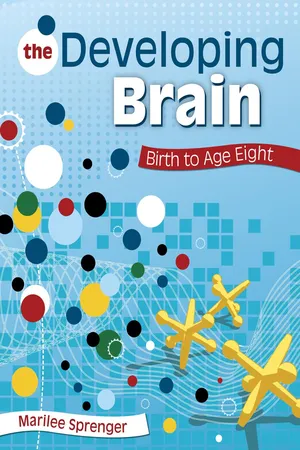Brain Development
Brain development refers to the process through which the brain grows, forms connections, and undergoes changes over time. It encompasses the physical and cognitive changes that occur from infancy through adulthood, including the development of neural pathways, synaptic pruning, and the acquisition of cognitive skills. Factors such as genetics, environment, and experiences play crucial roles in shaping brain development.
7 Key excerpts on "Brain Development"
- eBook - ePub
- Thomas Keenan, Subhadra Evans, Kevin Crowley(Authors)
- 2016(Publication Date)
- SAGE Publications Ltd(Publisher)
...As we will find out, Brain Development is an ongoing process, and you may be surprised to learn that parts of your brain – particularly the prefrontal cortex – continue to mature well into adulthood. The rest of this chapter will be devoted to exploring and understanding how the brain changes across development. And it does so in some unexpected ways. Before we continue, it is necessary to note that despite being vulnerable and sensitive in some ways, the brain and indeed much of our development are characterized by a good deal of resilience to internal and external threat. Although there are some ways in which we can foster and support brain maturation in children, for the most part as long as there are no major threats (such as abuse, neglect or a severe underlying genetic disorder; see Research Example 5.2), most brains will develop in just the right way to ensure we are able to learn and adapt to the needs of our environment. We mention this because there are a great many myths and sources of anxiety that have developed along with this area of research. For example, the idea that a certain television programme or toy can increase intelligence in babies has sparked the development of expensive products with little real benefit that are marketed to unsuspecting parents and childhood educators, who can be easy prey in their motivation to do what’s best for the children in their care (Twardosz, 2012; Zambo, 2008). In this chapter, we will also explore some of the facts and fictitious notions surrounding what supports and harms brain growth across development. There are at least three views to understanding how brain changes interact with behavioural development. Johnson (2005) identifies these as the processes of maturation, skill learning and interactive specialization. Maturation refers to the notion that Brain Development has a direct effect on skill acquisition: to put it simply, the brain grows and this leads to new behaviours...
- eBook - ePub
Brain Matters
Translating Research into Classroom Practice
- Patricia Wolfe(Author)
- 2010(Publication Date)
- ASCD(Publisher)
...Part 2 Brain Development from Birth Through Adolescence The brain is not only shaped by its inherited genetic code, but it is heavily influenced and shaped by its environment. If we were born with our brains completely developed, the study of human behavior would be much simpler. The growth of the body is relatively easy to observe; the growth of the brain is not. Until recently, we could only surmise what was going on in the brain by observing behavior, which led to many misconceptions. It was once believed that a baby's brain was a blank slate, a "tabula rasa," waiting and ready for instructions to be written. We now know that the truth is much more complex. Adolescent brains were once believed to be the same as their adult counterparts. This also is not true. Adolescent brains—as we shall see—do not reach adult functioning levels until perhaps their early 20s. In order to provide the best environment for the early years and to design appropriate instruction for children and adolescents during the years of formal schooling, we need to have a better understanding of the structure and function of the brain at the various stages of development. As we look at the developing brain, one of the most important concepts to understand is that of neuroplasticity. Simply stated, neuro plasticity means that the brain is shaped not only by its inherited genetic code but also by its environment. No other organ in the human body can boast this feat to the same degree. In his book The Synaptic Self, Joseph LeDoux sums this up well: "People don't come preassembled but are glued together by life. We all have a different set of genes and a different set of experiences" (2003, p. 3). For example, we know that the human brain is "programmed" at birth to hear—and eventually produce—the discrete sounds (phonemes) that constitute language...
- Donna Couchenour, J. Kent Chrisman(Authors)
- 2016(Publication Date)
- SAGE Publications, Inc(Publisher)
...Brain Development Brain Development Laura L. Brock Laura L. Brock Brock, Laura L. 162 167 Brain Development The brain undergoes remarkable change in early childhood. Brain Development begins in the womb, and much of the work is reserved for the first few years of life. Brain Development is shaped by experience; this is especially true in early childhood where environmental influence can impact long-term developmental trajectories. An understanding of Brain Development helps explain young children’s tremendous capacity for learning, behavioral regulation, and socioemotional competence. Early Brain Development Brain Development begins soon after conception. Within the first few weeks of conception, the neural tube develops and will eventually form the brain and spinal column. The major developmental task of the neural tube is to grow neurons, and this is achieved at a rate of 100,000 to 250,000 per minute. Neurons then specialize and migrate to genetically predetermined locations; differentiated neurons will later perform unique functions and comprise different regions of the brain. Four weeks after conception, early brain function is detectable and the head accounts for 50% of total fetal length. By birth, the brain contains over 100 billion neurons. It was once thought that neurogenesis, or the forming of new neurons, occurred only in utero. We now know that adults have the capacity to form new neurons (termed neurogenesis), but neural growth is never as prolific as in the womb. More important than the quantity of neurons is the strength of connections between neurons. A complex interconnected neural network is formed with dendrites drawing information toward neurons and axons passing that information along. Axons from one neuron nearly connect to dendrites from another neuron at synapses (the location or gap between the two nerve fibers). Neurotransmitters (chemical signals) or electrical currents flow along neural pathways to achieve communication between neurons...
- eBook - ePub
Child and Adolescent Psychology
Typical and Atypical Development
- Stephen von Tetzchner(Author)
- 2018(Publication Date)
- Routledge(Publisher)
...If the environment does not offer the expected experiences – as, for example, in cases of parental neglect – the result can be atypical Brain Development (Belsky and de Haan, 2011; Cicchetti, 2002). Experience-dependent processes become prominent later in development. They involve the development of networks of cells and synapses as the result of experience and thus represent adaptation to the child’s ecology. The more or less unique experiences of children affect the way in which the brain perceives and processes stimulation and initiates action, and thus contributes to individual differences in Brain Development and functioning (Cicchetti, 2002; Lewis, 2005). Brain Development The development of the brain is a complex process that begins when the fetus is about 2 weeks old and continues all the way into adulthood, involving complementary processes of producing as well as eliminating neurons and neural connections. Brain Development also includes cell migration, myelination and specialization (see below). Prenatal development The brain and the rest of the nervous system evolve from the outer layer of the embryo. After 2 to 3 weeks, this area begins to form an embryonic disc, which folds together into a closed neural tube. The cells in this tube produce new cells at an average rate of 250,000 per minute until birth (Ackerman, 1992). Gradually, the tube divides into layers, and cellular functions become more differentiated. Cell migration The overall structure of the brain is the same for all human beings. It is largely determined by genetic factors and has to do with which parts of the body the different areas of the brain are associated with. An important question is what causes cells to migrate and to specialize (see below). The instructions for cells to move to a particular area at the right time is probably part of the overall genetic blueprint, but this does not depend on the production of special cell types for each area by means of cell division...
- eBook - ePub
- Victoria Hall Moran, Nicola M. Lowe, Victoria Hall Moran, Nicola M. Lowe(Authors)
- 2016(Publication Date)
- CRC Press(Publisher)
...1 Nutritional and Environmental Influences on Brain Development Critical Periods of Brain Development, Pathways, and Mechanisms of Effect Bryan Kolb, Celeste Halliwell, and Robbin Gibb CONTENTS 1.1 Introduction 1.2 Brain Development in Humans and Rodents 1.3 Special Features of Brain Development 1.3.1 Stem Cells 1.3.2 Plasticity 1.4 Factors Influencing Brain Development in the Normal Brain 1.4.1 Sensory and Motor Experiences 1.4.2 Psychoactive Drugs 1.4.3 Stress 1.4.4 Peer Relationships 1.4.5 Parent–Child Relationships 1.4.6 Intestinal Flora 1.4.7 Early Brain Injury 1.4.8 Nutrition and Brain Development 1.5 Nutrition and Early Brain Injury 1.6 Conclusion Acknowledgement References 1.1 INTRODUCTION Brain and behavioural development is influenced by a wide range of factors, including nutrients. Although there is a considerable literature on the effects of early life nutrition on normal and abnormal behavioural development (e.g. Georgieff 2007; Georgieff & Rao 2001; Leung et al. 2011; Rucklidge & Kaplan 2013), far less is known about how early nutrition affects either brain plasticity or the effects of perinatal brain injury. The goal of this chapter is to introduce the reader to these issues. We begin with a brief review of Brain Development and plasticity, consider a model of early brain injury in rats, and then consider the role of nutrition in stimulating recovery and brain plasticity. 1.2 Brain Development IN HUMANS AND RODENTS Brain Development is a long and complex process that can broadly be divided into two phases in mammals. The first phase is in utero and reflects a genetically determined sequence of events that are modulated by the internal maternal environment and external factors that influence this environment. The second phase of the development is largely postnatal in species such as the rat but occurs in both pre- and postnatal periods in species such as humans...
- eBook - ePub
- Jamie Ward(Author)
- 2019(Publication Date)
- Routledge(Publisher)
...One particular current approach is termed neuroconstructivism (Westermann et al., 2007). Like Piaget’s approach, this assumes constant interaction between environment and genetic factors, with a mature cognitive system emerging out of transformations of earlier ones. Unlike Piaget’s approach, the predetermined aspect of development is construed in terms of multiple, brain-based constraints (developmental changes in synapse formation, myelination, etc.), rather than the less well-defined notion of predetermined “stages.” KEY TERM Nature–nurture debate The extent to which cognition and behavior can be attributed to genes or environment. Neuroconstructivism A process of interaction between environment and brain-based constraints that leads to the mature cognitive system emerging out of transformations of earlier ones (but does not assume discrete stages). This chapter will first consider the structural development of the brain, both prenatally and postnatally. It will then go on to consider the nature of developmental change, including evidence for critical/sensitive periods and innate knowledge. An overview of the origin of genetic differences and behavioral genetics will then explore some specific examples of genetic influences in developmental cognitive neuroscience. Together with the advances made in molecular genetics, it is now becoming possible to understand how genetic influences and experience create changes in the structure and function of the brain. This is leading to an exciting rethink of the nature–nurture debate. ADAPTING THE METHODS OF COGNITIVE NEUROSCIENCE FOR INFANTS AND CHILDREN Methods such as fMRI and EEG are generally considered suitable for infants and children. One advantage of using these methods in younger people is that they do not necessarily require a verbal or motor response to be made. Functional MRI Gaillard et al. (2001) provide an overview of some of the considerations needed...
- eBook - ePub
The Developing Brain
Birth to Age Eight
- Marilee B. Sprenger(Author)
- 2008(Publication Date)
- Corwin(Publisher)
...For this reason, scientists have been able to monitor the brain’s electrical activity and determine where and when this activity is strongest. This is another way to establish brain growth. Brain Briefing Human contact and touch promotes a sense of security and encourages healthy Brain Development. Neural networks grow out of our sensory experiences and begin forming the patterns for learning (Hannaford, 2005). WINDOWS OF OPPORTUNITY There are certain time periods when the brain appears to be very receptive to certain types of learning. These periods are called “windows of opportunity,” the ideal time to provide the input that these active brain areas require. Simply put, these time periods will involve any or all of the following components: 1. Dendritic growth in a specific area: more receivers of information 2. Synaptic density in a specific area: more space for connections between neurons 3. Myelination of a specific area: faster and easier transmission of messages 4. Increase in brain wave activity Although these windows do not slam shut, learning is much easier for the brain during these periods. Two windows are considered critical for normal development. Those windows are for vision and speech. If a baby is born with a cataract and it is not removed within the first several weeks of life, normal vision will not develop. That is not to say the child will not be able to see. It does indicate, at least, less than perfect vision. By the age of 12 a child will lose the ability to speak certain phonemes, so this is also a critical window, but one can see that with so many years allowed for development, this window closes slowly (Sousa, 2006). Brain Briefing IQ is not fixed at birth. Gone are the days of intelligence tests being able to predict the future for any child...






